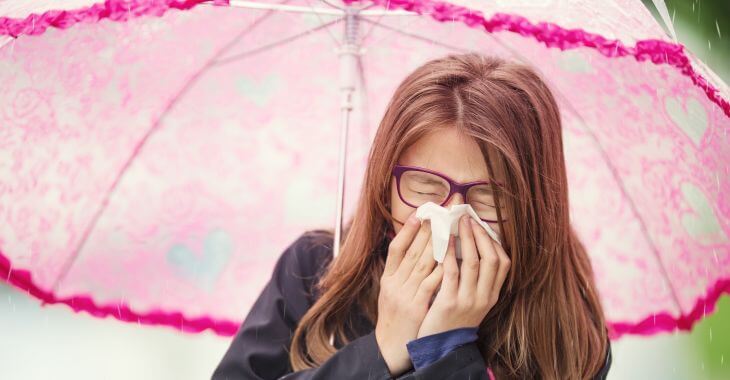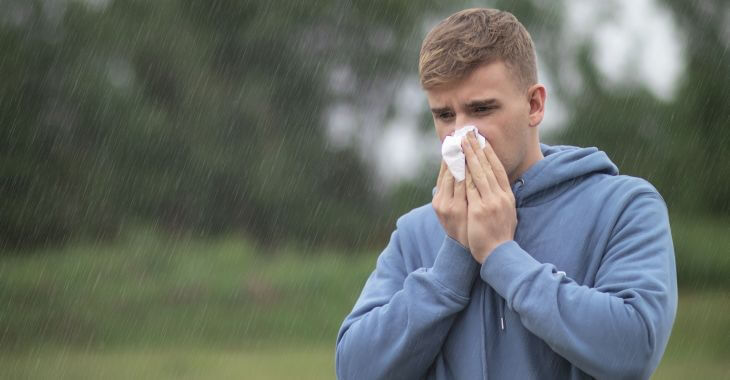Does Rain Make Allergies Worse? The Interplay Between Rainfall and Allergies

As individuals navigate the changing seasons, many find themselves grappling with the unpleasant symptoms of allergies. While common triggers include pollen, dust, and animal dander, there is often speculation about the role that rainfall plays. Why does rain make allergies worse?
Factors That Impact Allergies After Rain
The relationship between rain and allergies is multifaceted, involving a combination of factors that impact airborne allergens, environmental conditions the overall allergic experience. Understanding these various factors can unveil the interplay between rainfall and allergies.
Before delving into the intricacies of how rain may affect allergies, it is essential to dispel a common misconception. The rain itself does not inherently trigger allergies. Instead, the dynamics at play involve various indirect factors influenced by rainfall that can impact allergy symptoms.
Pollen Dynamics
Rain can have contrasting effects on pollen levels, depending on the timing, duration, and type of rainfall. Rainfall helps clear the air of pollen by causing it to settle on the ground. This can provide temporary relief for allergy sufferers, especially during and immediately after a rain shower.
Post-Rain Pollen Release
Paradoxically, rain can also contribute to increased pollen levels in some situations. For certain plants, rain serves as a trigger for releasing pollen. This phenomenon is more commonly observed after a period of rain, as plants respond to the moisture by releasing additional pollen into the air.
Consequently, individuals with pollen allergies may experience heightened symptoms during this post-rain period. This may result in allergies after rain appearing to be worse.
Mold Growth and Allergies
Mold is another significant allergen that can be influenced by rainfall. Mold spores thrive in damp conditions, and rain provides the moisture necessary for their growth. As rainwater accumulates in various outdoor and indoor environments, it creates a conducive setting for mold growth.
Individuals allergic to mold may experience exacerbated symptoms in the aftermath of rainfall, particularly in areas with high humidity levels.
Indoor Allergen Concerns
Rainfall can indirectly impact indoor allergens, contributing to allergic reactions. Leaky roofs, poorly sealed windows, and compromised foundations can allow rainwater to infiltrate homes, creating damp environments conducive to mold growth.
Air Quality Improvement
Despite the potential challenges posed by rain in relation to allergens, it also offers significant benefits. Rain acts as a natural purifier by effectively washing away airborne particles. During and after rain showers, the air tends to be cleaner, providing a respite for allergy sufferers.
Thunderstorms and Asthma
While not directly related to rain, thunderstorms can have a noteworthy impact on individuals with asthma and certain allergies. During thunderstorms, pollen grains can rupture into smaller particles, known as allergenic particles.
The smaller pollen particles can be easily inhaled into the lungs, triggering asthma attacks or exacerbating respiratory symptoms in susceptible individuals. Individuals with asthma may notice more frequent attacks after a rainstorm with thunder.
Individual Variability
It is important to recognize that the impact of rain on allergies can vary among individuals. Some people may find relief during and after rain, as it helps reduce airborne allergens.
In contrast, others may experience heightened symptoms due to increased pollen release or mold growth. Understanding one’s specific allergy triggers and reactions can aid in managing symptoms more effectively.
The Role of Local Flora
The specific types of vegetation prevalent in an area can influence the impact of rain on allergies. Understanding the local flora and their pollen-releasing behaviors can provide valuable insights into when and how allergies may be affected by rainfall.
Strategies for Allergy Management
Regardless of the relationship between rain and allergies, individuals can adopt various strategies to manage and alleviate symptoms. These may include:
- Monitoring Pollen Levels: Stay informed about local pollen forecasts, especially during and after rain, to anticipate potential increases in pollen concentrations.
- Indoor Allergen Control: Minimize indoor allergen exposure by using air purifiers, keeping windows closed during high pollen seasons and addressing any leaks or moisture issues that may contribute to mold growth.
- Personal Protection: When outdoor pollen levels are high, consider wearing sunglasses to protect your eyes, using allergen-proof bedding and showering after spending time outdoors to remove pollen from your body and hair.
- Consulting Allergy Specialists: For persistent or severe allergy symptoms, consulting with an allergy specialist can help identify specific triggers and develop personalized management plans, which may include allergy medications or immunotherapy.
Does rain make allergies worse? The relationship is a nuanced interplay of various factors, including pollen dynamics, mold growth and indoor allergen concerns. While rain can temporarily alleviate some airborne allergens, it may also contribute to the release of pollen and the growth of mold.

Recognizing individual variability and adopting proactive allergy management strategies can empower individuals to navigate allergy seasons with greater ease, even in the presence of rainfall.
If allergy symptoms persist or worsen after rainfall, seeking guidance from healthcare professionals or allergy specialists can lead to effective solutions tailored to individual needs.
The information provided on this website, including text, graphics, images, and other materials, is intended solely for informational purposes and should not be used as a substitute for professional medical advice, diagnosis, or treatment.




)